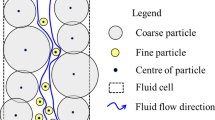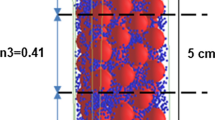Abstract
In this paper, a predictive model for simulating temporal behaviors of clayey sand during seepage-induced erosion has been developed by coupling discrete element method (DEM) with computational fluid dynamics (CFD). In this model, the particle–fluid coupling simulation is solved by a “fixed coarse-grid” scheme in 3D particle flow code (PFC3D), and the suffusion of clay matrix in the initiation of erosion is converted to a degradation process of bonding strength between particles according to a degradation law. The law is derived from the well-known shear stress threshold law dealing with soil internal erosion, which is based on two erosion parameters—the critical shear stress and the erosion coefficient. Then the degradation law is implemented in the CFD–DEM model via developing customized code using the Python language. The ability of the model to predict the interfacial erosion of soils is confirmed by two numerical tests. The results are seen to match the empirical criteria, such as revealing a clearly defined critical tangential shear stress, beyond which erosion occurs, and a positive correlation between the rate of erosion and the pressure gradient. It is believed that the numerical model is able to reproduce the time-dependent evolution process of seepage-induced erosion in clayey sand.
















Similar content being viewed by others
Abbreviations
- m :
-
Soil erosion velocity
- H :
-
Erodibility factor
- X :
-
Flow variable
- \(k_{\text{er}}\) :
-
Coefficient of surface erosion
- \(\varvec{\tau}\) :
-
Shear stress at the interface
- \(\tau_{c}\) :
-
Threshold shear stress
- b :
-
Exponent
- \(\Delta P_{j}\) :
-
Pressure drop
- n :
-
Cell porosity
- \(x_{j} \;(j = 1,2,3) \,\) :
-
Cell size in three directions (m)
- K :
-
Matrix permeability (m2)
- d eff :
-
Effective diameter of particle (m)
- S 0 :
-
Specific surface area (m2)
- r i, r j, r k :
-
Particle radius
- n b :
-
Number of particles in a cell
- N :
-
Total number of particles in the model
- n c :
-
Number of fluid cells
- \(V_{{i\_{\text{overlop}}}}\) :
-
Volume of overlap between a ball and a fluid cell
- \(\tau_{{{\text{cell}}\_i}}\) :
-
Tangential shear stress of the fluid cell i
- \(M_{\text{clay}}\) :
-
Mass of clay matrix
- \(M_{\text{grain}}\) :
-
Mass of grain matrix
- \(\omega\) :
-
Clay–aggregate ratio
- \(m_{{j\_{\text{clay}}}}\) :
-
Clay mass “occupied” by ball j
- \(\lambda ,\lambda_{\text{coh}} ,\lambda_{\text{ten}}\) :
-
Coefficients of bonding strength
- \(R_{j\_s}\) :
-
Shear strength of the bonds around ball j
- \(R_{j\_t}\) :
-
Tensile strength of the bonds around ball j
- \(C_{i}\) :
-
Cohesion of contact i
- \(T_{i}\) :
-
Tensile strength of contact i
- n j :
-
Contact number associated with ball j
- n k :
-
Contact number associated with ball k
- \(\beta\) :
-
The contact radius multiplier
- S i :
-
Area of contact i
- \(\tau_{j} ,\tau_{k}\) :
-
Shear stress at the surface of ball j and ball k
References
Arulanandan K, Perry EB (1983) Erosion in relation to filter design criteria in earth dams. J Geotech Eng 109(5):682–698
Bendahmane F, Marot D, Alexis A (2008) Experimental parametric study of suffusion and backward erosion. J Geotech Geoenviron 134(1):57–67
Bianchi F, Wittel FK, Thielmann M, Trtik P, Herrmann HJ (2018) Tomographic study of internal erosion of particle flows in porous media. Transp Porous Media 122(1):169–184
Bonelli S, Marot D (2011) Micromechanical modeling of internal erosion. Eur J Environ Civ Eng 15(8):1207–1224
Bouddour A, Auriault JL, Mhamdi-Alaoui M (1996) Erosion and deposition of solid particles in porous media: homogenization analysis of a formation damage. Transport Porous Media 25(2):121–146
Brumby PE, Sato T, Nagao J, Tenma N, Narita H (2015) Coupled LBM–DEM micro-scale simulations of cohesive particle erosion due to shear flows. Transport Porous Media 109(1):43–60
EI Shamy U, Zeghal M (2005) Coupled continuum-discrete model for saturated granular soils. J Eng Mech 131:413–426
Fannin RJ, Slangen P (2014) On the distinct phenomena of suffusion and suffosion. Géotech Lett 4(4):289–294
Faulkner H (2006) Piping hazard on collapsible and dispersive soils in Europe. In: Boardman J, Poesen J (eds) Soil erosion in Europe. Wiley, Chichester
Foster M, Fell R, Spannagle M (2000) The statistics of embankment dam failures and accidents. Can Geotech J 37(5):1000–1024
Golay F, Bonelli S (2011) Numerical modeling of suffusion as an interfacial erosion process. Eur J Environ Civ Eng 15(8):1225–1241
Golay F, Lachouette D, Bonelli S, Seppecher P (2010) Interfacial erosion: a three-dimensional numerical model. CR Mécanique 338(6):333–337
Golay F, Lachouette D, Bonelli S, Seppecher P (2011) Numerical modelling of interfacial soil erosion with viscous incompressible flows. Comput Methods Appl Mech Eng 200(1–4):383–391
Govers G, Loch RJ, Govers G, Loch RJ (1993) Effects of initial water content and soil mechanical strength on the runoff erosion resistance of clay soils. Soil Res 31(5):549–566
Hanson GJ, Cook KR, Simon A (1999) Determining erosion resistance of cohesive materials. In: Proc ASCE Int Water Res Eng Con Seattle, WA
Hu Z, Zhang Y, Yang Z (2019) Suffusion-induced deformation and microstructural change of granular soils: a coupled CFD–DEM study. Acta Geotech 14(3):795–814
Indraratna B, Nguyen VT, Rujikiatkamjorn C (2011) Assessing the potential of internal erosion and suffusion of granular soils. J Geotech Geoenviron 137(5):550–554
Itasca Consulting Group Inc. (2008) PFC3D Particle Flow Code in 3 dimensions user’s guide
Jäger R, Mendoza M, Herrmann HJ (2017) Channelization in porous media driven by erosion and deposition. Phys Rev E 95(1):013110
Jäger R, Mendoza M, Herrmann HJ (2018) Clogging at pore scale and pressure-induced erosion. Phys Rev Fluids 3(7):074302
Jiang NJ, Soga K, Kuo M (2016) Microbially induced carbonate precipitation for seepage-induced internal erosion control in sand–clay mixtures. J Geotech Geoenviron 143(3):04016100
Kenney TC, Lau D (1985) Internal stability of granular filters. Can Geotech J 22(2):215–225
Knapen A, Poesen J, Govers G, Gyssels G, Nachtergaele J (2007) Resistance of soils to concentrated flow erosion: a review. Earth Sci Rev 80(1–2):75–109
Leonardi CR, McCullough JWS, Jones BD, Williams JR (2016) Electromagnetic excitation of particle suspensions in hydraulic fractures using a coupled lattice Boltzmann-discrete element model. Comput Part Mech 3(2):125–140
Lindow N, Fox GA, Evans RO (2009) Seepage erosion in layered stream bank material. Earth Surf Proc Land 34(12):1693–1701
Lyle WM, Smerdon ET (1965) Relation of compaction and other soil properties to erosion resistance of soils. Trans ASABE 8(3):419–0422
Marot D, Le VD, Garnier J, Thorel L, Audrain P (2012) Study of scale effect in an internal erosion mechanism: centrifuge model and energy analysis. Eur J Environ Civ Eng 16(1):1–19
Mercier F, Bonelli S, Golay F, Anselmet F, Philippe P, Borghi R (2015) Numerical modelling of concentrated leak erosion during Hole Erosion Tests. Acta Geotech 10(3):319–332
Moffat R, Fannin RJ, Garner SJ (2011) Spatial and temporal progression of internal erosion in cohesionless soil. Can Geotech J 48(3):399–412
Nearing MA, Norton LD, Bulgakov DA, Larionov GA, West LT, Dontsova KM (1997) Hydraulics and erosion in eroding rills. Water Resour Res 33(4):865–876
Nguyen CD, Benahmed N, Andò E, Sibille L, Philippe P (2019) Experimental investigation of microstructural changes in soils eroded by suffusion using X-ray tomography. Acta Geotech 14(3):749–765
Onate E, Idelsohn SR, Celigueta MA (1970) Rossi R (2008) Advances in the particle finite element method for the analysis of fluid–multibody interaction and bed erosion in free surface flows. Comput Methods Appl Mech Eng 19–20:1777–1800
Poesen J, Savat J (1981) Detachment and transportation of loose sediments by raindrop splash: part II. Detachability and transport ability measurements. CATENA 8(1):19–41
Reddi LN, Lee I, Bonala MVS (2000) Comparison of internal and surface erosion using flow pump test on a sand-kaolinite mixture. Geotech Test J 23(1):116–122
Revil A, Grauls D, Brévart O (2002) Mechanical compaction of sand/clay mixtures. J Geophys Res Sol Earth 107(B11):2293
Richards KS, Reddy KR (2007) Critical appraisal of piping phenomena in earth dams. Bull Eng Geol Environ 66(4):381–402
Shaikh A, Ruff JF, Charlie WA, Abt SR (1988) Erosion rate of dispersive and nondispersive clays. J Geotech Eng 114(5):589–600
Shimizu Y, Hart R, Cundall P (2004) Numerical modeling in micromechanics via particle methods. In: 2004: Proc 2nd International PFC Symposium, Kyoto, Japan. CRC Press, pp 28–29
Tao H, Tao J (2017) Quantitative analysis of piping erosion micro-mechanisms with coupled CFD and DEM method. Acta Geotech 12(3):573–592
Tomlinson SS, Vaid YP (2000) Seepage forces and confining pressure effects on piping erosion. Can Geotech J 37(1):1–13
Trani LDO, Indraratna B (2010) The use of particle size distribution by surface area method in predicting the saturated hydraulic conductivity of graded granular soils. Géotechnique 60(12):957–962
Tsuji Y, Kawaguchi T, Tanaka T (1993) Discrete particle simulation of two-dimensional fluidized bed. Powder Technol 77(1):79–87
Tucker GE (2004) Drainage basin sensitivity to tectonic and climatic forcing: implications of a stochastic model for the role of entrainment and erosion thresholds. Earth Surf Proc Land 29(2):185–205
Utley BC, Wynn TM (2008) Cohesive soil erosion: theory and practice. In: World Environmental and Water Resources Congress Ahupua’A, pp 1–10
Verachtert E, Van Den Eeckhaut M, Poesen J, Deckers J (2013) Spatial interaction between collapsed pipes and landslides in hilly regions with loess-derived soils. Earth Surf Proc Land 38(8):826–835
Wang M, Feng YT, Pande GN, Chan AHC, Zuo WX (2017) Numerical modelling of fluid-induced soil erosion in granular filters using a coupled bonded particle lattice Boltzmann method. Comput Geotech 82:134–143
Wilson GV, Cullum RF, Römkens MJM (2008) Ephemeral gully erosion by preferential flow through a discontinuous soil-pipe. CATENA 73(1):98–106
Wilson GV, Rigby JR, Dabney SM (2015) Soil pipe collapses in a loess pasture of Goodwin Creek watershed, Mississippi: role of soil properties and past land use. Earth Surf Proc Land 40(11):1448–1463
Wood DM, Maeda K, Nukudani E (2010) Modelling mechanical consequences of erosion. Geotechnique 60(6):447–457
Woodward DE (1999) Method to predict cropland ephemeral gully erosion. CATENA 37(3–4):393–399
Wynn TM, Henderson MB, Vaughan DH (2008) Changes in streambank erodibility and critical shear stress due to subaerial processes along a headwater stream, southwestern Virginia, USA. Geomorphology 97(3–4):260–273
Zhang F, Li M, Peng M, Chen C, Zhang L (2019) Three-dimensional DEM modeling of the stress–strain behavior for the gap-graded soils subjected to internal erosion. Acta Geotech 14(2):487–503
Acknowledgements
This work was supported by the National Natural Science Foundation of China (Nos. 41672300, 41472245, 41602301, and 51622803), the Fundamental Research Funds for the Central Universities (No. 106112016CDJZR208804), and the China Postdoctoral Science Foundation (No. 2018M643414).
Author information
Authors and Affiliations
Corresponding author
Additional information
Publisher's Note
Springer Nature remains neutral with regard to jurisdictional claims in published maps and institutional affiliations.
Rights and permissions
About this article
Cite this article
Gu, D.M., Huang, D., Liu, H.L. et al. A DEM-based approach for modeling the evolution process of seepage-induced erosion in clayey sand. Acta Geotech. 14, 1629–1641 (2019). https://doi.org/10.1007/s11440-019-00848-0
Received:
Accepted:
Published:
Issue Date:
DOI: https://doi.org/10.1007/s11440-019-00848-0




